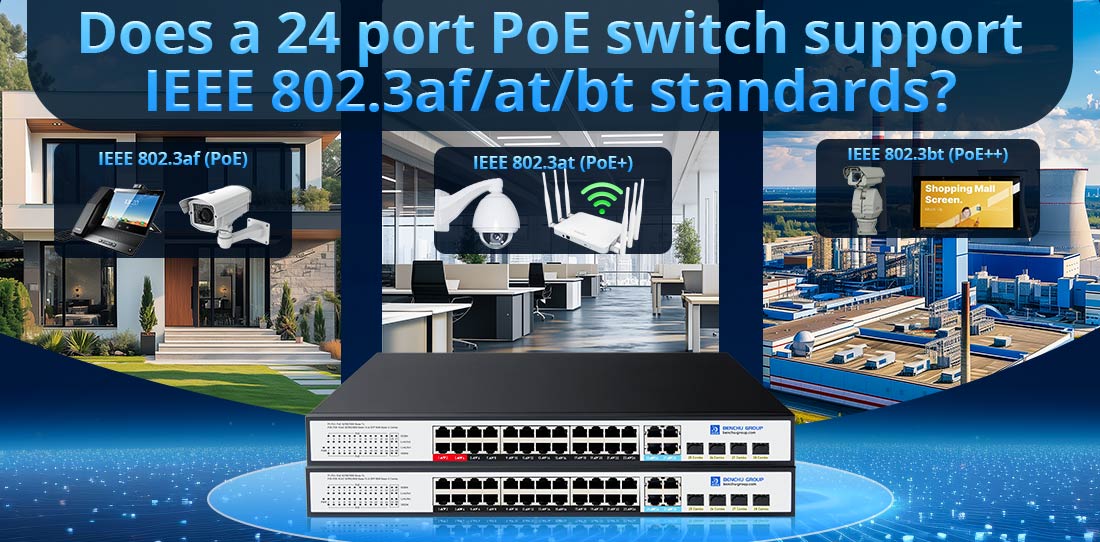
Поддерживает ли 24-портовый коммутатор PoE стандарты IEEE 802.3af, 802.3at или 802.3bt, зависит от модели и конструкции коммутатора. Каждый стандарт определяет различные возможности подачи питания, и коммутатор может поддерживать один или несколько из них. Ниже приводится подробное объяснение этих стандартов и их отношения к 24-портовым коммутаторам PoE.
1. Обзор стандартов PoE
Каждый стандарт PoE определяет максимальную мощность, которую коммутатор может передать подключенным устройствам через кабели Ethernet:
IEEE 802.3af (PoE):
--- Максимальная мощность на порт: 15,4 Вт у источника (коммутатора), до устройства доходит ~12,95 Вт (после потерь в кабеле).
--- Приложения: Устройства с низким энергопотреблением, такие как IP-телефоны, базовые IP-камеры и точки беспроводного доступа начального уровня.
--- Совместимость: Большинство современных коммутаторов PoE, включая многие 24-портовые модели, поддерживают этот стандарт.
IEEE 802.3at (PoE+):
--- Максимальная мощность на порт: 30 Вт у источника, ~25,5 Вт подается на устройство.
--- Приложения: Устройства средней мощности, такие как PTZ-камеры, расширенные точки доступа и видеотелефоны.
--- Совместимость: Многие 24-портовые коммутаторы поддерживают PoE+ в дополнение к PoE, что делает их универсальными для сетей со смешанным количеством устройств.
IEEE 802.3bt (PoE++):
Максимальная мощность на порт:
--- Тип 3: 60 Вт (подходит для таких устройств, как уличные точки доступа и светодиодное освещение).
--- Тип 4: 90 Вт (подходит для мощных устройств, таких как PTZ-камеры с обогревателями или большие цифровые вывески).
Приложения: Мощные устройства, такие как камеры высокого разрешения, промышленное оборудование Интернета вещей и интеллектуальное освещение.
Совместимость: Подмножество высококлассных 24-портовых коммутаторов поддерживает этот стандарт. Это требует более высокого общего бюджета мощности.
2. Поддержка нескольких стандартов в 24-портовом коммутаторе PoE.
Обратная совместимость: Коммутатор, поддерживающий более высокий стандарт (например, 802.3bt), также будет поддерживать более низкие стандарты (802.3af и 802.3at). Это обеспечивает совместимость со старыми устройствами или устройствами с меньшим энергопотреблением.
Смешанная среда: Многие современные 24-портовые коммутаторы PoE разрешить некоторым портам обеспечивать 802.3bt (более высокую мощность), а другим — 802.3af или 802.3at, чтобы сбалансировать бюджет мощности.
3. Определение совместимости
При оценке 24-портового PoE-переключатель для поддержки 802.3af/at/bt учитывайте следующее:
Бюджет мощности:
Коммутатор должен иметь достаточный общий бюджет мощности для поддержки стандартов.
--- PoE: Типичный 24-портовый коммутатор мощностью 250–300 Вт может одновременно питать большинство устройств 802.3af.
--- PoE+: Для смешанных сред с устройствами 802.3at часто требуется бюджет мощности 400–600 Вт.
--- РоЕ++: Для устройств 802.3bt высокой мощности требуется бюджет 750 Вт или более, в зависимости от количества портов, обеспечивающих максимальную мощность.
Характеристики порта:
Некоторые 24-портовые коммутаторы PoE могут не обеспечивать одинаковую мощность на всех портах.
--- 802.3af/at: Большинство портов будут поддерживать эти стандарты.
--- 802.3бт: Только определенные порты (например, 4–8) могут поддерживать более высокие уровни мощности из-за аппаратных ограничений.
Документация производителя:
--- Всегда проверяйте спецификации производителя, чтобы узнать, какие стандарты поддерживает коммутатор.
--- Ищите такие термины, как «802.3af/at/bt-совместимый» или «PoE++, поддержка типа 3/типа 4».
4. Примеры конфигураций 24-портового коммутатора PoE
Вот как различные типы 24-портовых коммутаторов PoE поддерживают стандарты IEEE:
Базовый коммутатор PoE:
Поддерживает 802.3af и ограниченный 802.3at.
--- Общий бюджет мощности: ~250–300 Вт.
--- Вариант использования: Небольшие офисы с IP-телефонами, базовыми камерами и точками доступа.
Коммутатор PoE+ среднего уровня:
--- Поддерживает 802.3af и 802.3at на всех 24 портах.
--- Общий бюджет мощности: ~400–600 Вт.
Вариант использования: Сети среднего размера со множеством камер, VoIP-телефонов и некоторых PTZ-камер.
Высококачественный коммутатор PoE++:
--- Поддерживает 802.3af, 802.3at и 802.3bt (тип 3 или тип 4).
--- Общий бюджет мощности: ~750–1000 Вт или выше.
Вариант использования: Крупные сети с устройствами высокой мощности, такими как PTZ-камеры с обогревателями, светодиодное освещение или интеллектуальное строительное оборудование.
5. Заключение
24-портовый коммутатор PoE может поддерживать IEEE 802.3af, 802.3at или 802.3bt, в зависимости от модели и ее мощности:
--- Для базовых сетей с маломощными устройствами достаточно поддержки 802.3af/at.
--- Для расширенных сетей, требующих устройств высокой мощности, убедитесь, что коммутатор поддерживает 802.3bt.
При выборе коммутатора учитывайте требования к питанию ваших устройств, общий бюджет мощности и совместимость коммутатора с этими стандартами, чтобы обеспечить оптимальную производительность.